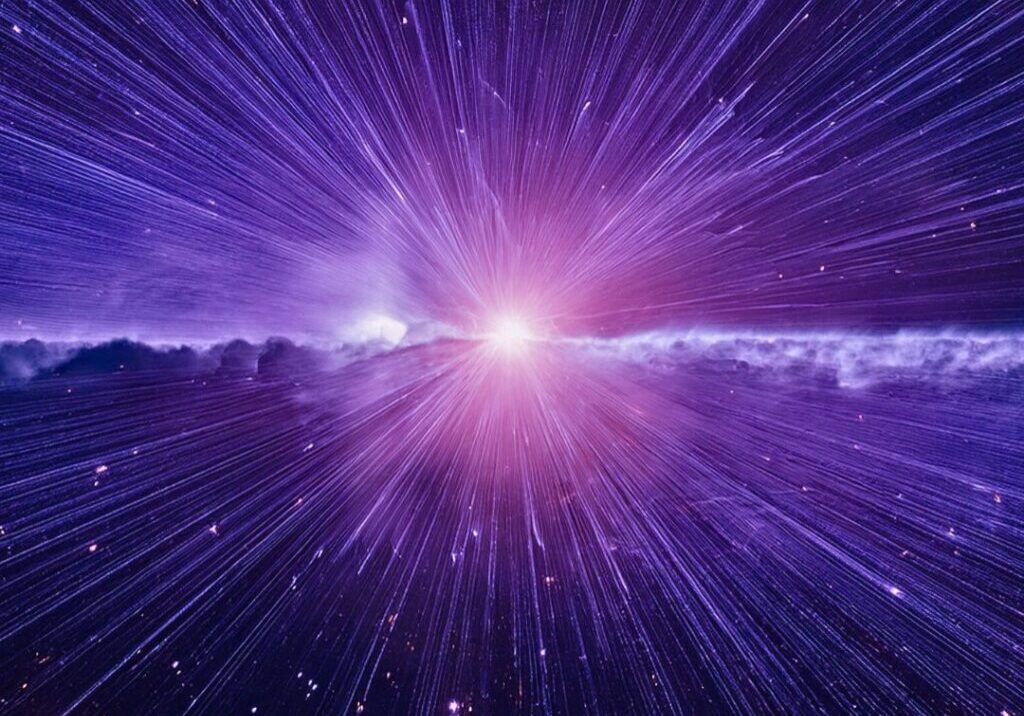A Deep Dive into Cosmotheandrism
In a previous post, I explored the idea of a cosmotheandric language of belonging and resolved that “without the wild energy of Ruach our religious endeavors are cut off from their very source and destination.”[1] In this piece I would like to take a deeper dive into cosmotheandrism by putting Loren Eiseley’s story “The Dance of the Frogs” in conversation with theology and science.
Raimon Panikkar’s word “cosmotheandric”[2] indicates a wholeness through intersubjectivity; the cosmos, God and humans participate in the substance and activity of one another. Theologian Douglas Burton-Christie asserts that poetry and literature play “a crucial role in re-imagining our relationship with the natural world” [3] and in doing so, I suggest, provide insight into Panikkar’s theology. Burton-Christie sees the literary genre of nature writing as a liminal space in which “it becomes possible to imagine the apparently impermeable boundaries that separate one place from another, spirit from matter, ourselves from other living species, ourselves from God, as permeable.”[4]
Nature writer Loren Eiseley’s story, “The Dance of the Frogs,” illustrates this permeability. In this piece, a young, unnamed scientist comes across Albert Dreyer, an esteemed and mysterious elder scientist, in a tavern. In a rare moment, Dreyer, who is usually private and sedate, divulges his experience of being caught up in the Spring rite of the frogs returning to the water for mating and laying eggs. He recalls, “The water was pulling them – not water as we know it, but the mother, the ancient life force, the thing that made us in the days of creation, and that lurks around us still, unnoticed in our sterile cities.”[5] Dreyer was being pulled as well, and became a spontaneous participant in the Spring rite: “Even as I leaped, I was changing. It was this, I think, that stirred the last remnants of human fear and human caution that I still possessed. My will was in abeyance; I could not stop. Furthermore, certain sensations, hypnotic or otherwise, suggested to me that my own physical shape was modifying, or about to change. I was leaping with a growing ease.”[6]
Dreyer continues, “It was just then that the wharf lights began to show. We were approaching the end of the road, and the road, as I have said, ended in the river. It was this, I suppose, that startled me back into some semblance of human terror. Man is a land animal. He does not willingly plunge off wharfs at midnight in the monstrous company of amphibious shadows.”[7] Dreyer explains, “Nevertheless their power held me. We pounded madly toward the wharf, and under the light that hung above it, and the beam that made a cross. Part of me struggled to stop, and part of me hurtled on. But in that final frenzy of terror before the water below engulfed me I shrieked, Help! In the name of God, help me! In the name of Jesus, stop![8]
As he reflects on his research with frogs, Dreyer confesses, “I have never been able to handle them for research since. My work is in the past.”[9] Earlier in the story the readers are told that Dreyer wears a black glove on one hand. Dreyer now uncovers the mystery of the glove: “He paused and drank, and then, seeing perhaps some lingering doubt and confusion in my eyes, held up his black-gloved hand and deliberately pinched off the glove. A man should not do that to another man without warning, but I suppose he felt I demanded some proof. I turned my eyes away. One does not like a webbed batrachian hand on a human being.[10]
Although Eiseley’s piece is fictional, it points to the Teilhardian idea of a cosmic drive towards unity and wholeness. Ilia Delio captures this drive when she writes, “God and the world consummate their desire for one another in the marriage of heaven and earth, precisely because God and world are entwined in creative union.”[11] She further explains: “Each in its own way exists in itself and with the other, so that the creative movement of life is always toward the fullness of love, a movement that is at once divine, created and cosmic…In Christ, God and cosmos are entangled in love and brought to explicit consciousness in Jesus of Nazareth.”[12]
Theologian Paul Fiddes similarly asserts that “the divine Word will not be spoken without physical meditation. God takes on bodies in order to draw us into the triune relationships in God.”[13] According to Fiddes, “God happens in an interweaving flow of relationships like those between a father and a son, opened up and deepened by the currents of the Spirit.”[14] We participate in these movements, which can also be gendered as female, through loving relationships.
If we are to understand Trinity as participative, both spirituality and materiality, we might interpret the ancient life force in Eiseley’s story as the love energy of the triune God through which all came to be; the allurement that continues to draw all of creation into unitive relationships; the cosmic Mother who draws her children back to herself. It is this primal force that draws the frogs and Dreyer to the water to participate in a procreative Springtime ritual and, I suggest, into the maternal dimension of the Trinity. It is noteworthy that Dreyer sees a cross as he takes the plunge towards the renewal of life, suggesting a spiritual aspect to his surrender that is reminiscent of Jesus’ transformative self-emptying.
While the chimerism[15] of Eiseley’s fiction seems unlikely, scientists have discovered that it exists within humans. Fetal-maternal microchimerism occurs during pregnancy when cells are exchanged between a fetus and the mother. The fetal cells can remain in the mother for decades. While their effect has not been definitively established, recent data indicate “the promising role of microchimeric cells in the maternal response to tissue injuries by differentiating into many lineages.”[16]
What are the theological implications of fetal-maternal microchimerism? What do thinking, loving, and reciprocity look like in intersubjective spaces? Humans are changed by our encounters with other humans and with creation. In Eiseley’s story, Dreyer’s webbed batrachian hand is an outward sign of his inner transformation. As a result of Dreyer’s empathic fusion[17] with the frogs, he becomes more compassionate and can no longer do research with frogs, as he is now one with them. We are a conglomeration of all we have loved and all that has changed us. We bring our multiple selves to our relationships, as do all members of the cosmotheandric whole. Abiding in our Mother, may we think with the mind of God and the nimbleness of leaping frogs, and love with the heart of God, the allurement of Spring, and the fecundity of ancient, primal waters.
[1] Emily DeMoor, “A Cosmotheandric Language of Belonging,” New Creation, Center for Christogenesis, https://christogenesis.org/a-cosmotheandric-language-of-belonging/
[2] Cit. Ilia Delio. The Hours of the Universe. Reflections on God, Science, and the Human Journey. (Maryknoll, NY: Orbis Books), 45.
[3] Douglas Burton-Christie. “Mapping the Sacred Landscape: Spirituality and the Contemporary Literature of Nature.” Horizons 21:1 (1994): 22-47.
[4] Douglas Burton-Christie, “A Sense of Place,” The Way 29/1 (1999), p.64.
[5] Loren Eiseley, L. C., “The Dance of the Frogs,” The Star Thrower. New York: Harcourt Brace & Company, 1978, 112.
[6] Loren Eiseley, “Dance,” 114.
[7] Loren Eiseley, “Dance,” 114.
[8] Loren Eiseley, “Dance,” 114.
[9] Loren Eiseley, “Dance,” 115.
[10] Loren Eiseley, “Dance,” 115.
[11] Ilia Delio, Primacy, 32-33.
[12] Ilia Delio, Primacy, 34.
[13] Paul S. Fiddes, Participating in God: A Pastoral Doctrine of the Trinity. Louisville, Kentucky: Westminster John Knox Press, 2000, 227.
[14] Paul S. Fiddes, Participating in God, 281.
[15] In Greek mythology a chimera was a “fire-breathing she-monster,” with the head of a lion, the body of a goat, and the tail of a serpent; “an imaginary monster compounded of incongruous parts.” Merriam-Webster.com Dictionary, s.v. “chimera,” accessed November 11, 2022, https://www.merriam-webster.com/dictionary/chimera.
[16] Olav Lapaire , Irène Hösli, Rosanna Zanetti-Daellenbach, Dorothy Huang, Carmen Jaeggi, Susanne Gatfield-Mergenthaler, Sinuhe Hahn, & Wolfgang Holzgreve , “Impact of fetal-maternal microchimerism on women’s health–a review,” NIH National Library of Medicine, National Center for Biotechnology Information. https://pubmed.ncbi.nlm.nih.gov/17437192/.
[17] Jose Vasconcelos proposed coined the term ‘empathetic fusion’ to describe an encounter in which a person or subject loses him or herself in the experience of connection. Roberto S. Goizuetta, Caminemos Con Jesús: Toward A Hispanic/Latino Theology of Accompaniment. Maryknoll (New York: Orbis Books, 1995), 91. See José Vasconcelos, Obras Completas, 4 vols (México, DF: Libreros Mexicanos Unidos, 1958–61), 4:16.
 View print-friendly version
View print-friendly version
10 Comments
Related Posts

The Earth Groans, AI Grows: Who Guides the Flame?
In this critical moment of planetary history, where ecosystems collapse, artificial intelligence proliferates, and human meaning trembles on the edge of uncertainty, we are faced with a profound question: What kind…


Astralstar,
Maybe Eiseley’s ambiguity regarding the scientists’ plunge is intended to provide an opening for the readers to decide whether they themselves are going to fully plunge into the ancient, yet ever new, life-giving waters?
Astralstar,
Your reflection on the piece is really beautiful and insightful. In terms of the dance of the frogs, it seems that Loren Eiseley leaves it up to the reader to decide. My take is that the scientist did, in fact, take the plunge, but held part of himself out of the experience, so as not to lose himself entirely.
I love what you write about the cross: “This is this time, the place, the intersection, where all of nature meets and acknowledges that falling off the wharf into the great unknown is so radically risky yet it is required to create conditions for ALL to survive.” I have some further thoughts on this as well, and would like to develop them more, perhaps in a written piece. There’s something about the vertical meeting the horizontal, as depicted in the Zen frog haiku by Basho, that speaks to the intersection of the immanent (horizontal) and the transcendent (vertical), which is, as you point out, ongoing:
Ancient Pond,
Frog jumps in,
Plop…..
George, I appreciate the idea that love fuses two into one. It seems that the arts provide the language for this fusion, as you say. Once we start seeing and living this way, so many things change.
George, many ancient beliefs understood the sacred marriage, hieros gamos, to unite and celebrate the entanglement of the feminine and masculine life and recognized the powerful symbolic meaning of this joining. The 2 becoming one. Two gathered in Their presence and the powerful God essence is/was present.
How awakened was their consciousness! Intuitively feeling the wisdom connecting the Christ firmament to life.
One God, many manifestations, many names!
Attractive and necessary! Nearly every religion and spiritual discipline has The One-time no matter how many manifestations of the deity.
Amen. Couldn’t agree with you more!
As one who follow a Divine Mother-Father God( a God created through hieros gamos, through Love), I read your piece and said, “Yes! Yes,! Yes!”.
We are one with all we allow ourselves to consciously connect with and accept into our experience. This is our constructed reality. This conscious acceptance creates an Awakening, a personalized cosmos which we freely give back to the kenotic dance of flow. Willingly emptying this precious gift to the community of all believers.
In ” The Frog Dance” it sounds as if the ultimate giving, the ” Kobi” scenerio ( the good of the one outweighs the needs of the many” was not carried to conclusion?
Ultimate giving is hard.
Maternal Michrocherism is such a scenario. One twin gives its live for another. Becomes part of the Whole.
Yet, any fetus becomes part of the mother through Michrocherism. Remain with her for decades. Wholes into greater wholes.
For me, the cross symbolizes NOW. This is this time, the place, the intersection, where all of nature meets and acknowledges that falling off the wharf into the great unknown is so radically risky yet it is required to create conditions for ALL to survive.
We must embrace our link with “mother slime” who provided the first one celled organism which eventually led to us. Who knows what will come next?
Joe, I appreciate your wonderful insights! I’ve read them a few times, as they are so rich! Thank you for extending the ideas of this piece even further.
These ideas are very attractive. As the human race evolves, differences are less important, commonality more evident. Love fuses two into one. This idea appears often in literature, especially in poetry and song lyrics, as in the song “I’m in the Mood for Love’–one line is “Now we are one, I’m not afraid.” Further, sexuality today presents greater variety than past generations may have taught, and growing numbers of people accept the fusions of male and female as a wondrous mystery rather than a puzzling oddity.
Great piece on the deep dive via the frog story. Thank you. Said the poet Goethe, “all things are metaphors,” windows to the eternal. We too are amphibious, having a foot in the material (visible) and spiritual (invisible) worlds at the same time, both worlds seamlessly co-present to each. They only appear separate to dualistic perception and discursive thought (the carnal mind). Spiritual consciousness brings them together in binocular (stereoscopic) focus, the corrective lens that sees clearly in unitive consciousness. I prefer the term “non-dual literacy,” learning how to see all of creation as one, embedded in a universal (quantum) matrix that undergirds all things. The elementary particles and cosmic forces comprising that hidden matrix comprise the substance of all material form in space-time, and at all scales, quark to quasar. Such is also coming full circle, a via a return to the divine feminine (matrix from the L. “mater,” meaning ‘mother.’) Recall, in the pre-Abrahamic religions all the deities were feminine, replaced, suppressed, and alienated via exclusive patriarchal (left brain) dominance, clergy, images, and language. The chronic symptoms of same, a stubborn “3rd-eye blindness” and subsequent illiteracy is currently being redeemed, not only reconciling balanced male/female notions of the divine, but understanding that creation itself is embedded in an indivisible matrix (alma mater) calling all things back to itself in individual and collective history —as water draws amphibians to itself creating new life in springtime renewal. Jesus calling the scattered and divided aspects of humanity back to himself in whole/making for non-dual literacy “as a hen gathers her brood” is a feminine image. And one day will culminate in the Omega Point of history, marked by the creation (birthing)of “a new heaven and a new earth” (Rev. 21:5).